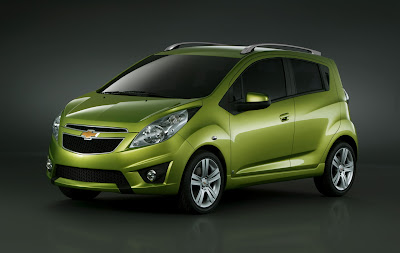2010 Chevy Spark
Monday, December 20, 2010

The all-new Chevrolet Spark, makes its world premiere at the 2009 Geneva Motor Show, is a small car designed to make a big statement. It's big on style, big on fuel economy and, like all products carrying the gold bowtie, big on value.
With punchy 1.0 and 1.2-liter four-cylinder gasoline engines and a five-door hatchback body format offering surprising versatility, the Chevy Spark is set to light up mini-car segment.

Inspired cabin
The progressive design of Chevrolet Spark's surprisingly spacious cabin has the flair to match its exterior looks. The use of quality materials and an uplevel execution were key interior design requirements, demonstrating that small cars offering big value need not look utilitarian or spartan inside.
Bright and engaging, the interior features an evolution of Chevrolet's signature 'dual cockpit' design. The textured front fascia moldings flow each side of the cabin into the doors, creating a feeling of space that belies Chevrolet Spark's diminutive size.
Exterior bodywork colors are carried through into the lower fascia and door panels. And the main controls are all highlighted in signature Chevy ice-blue, adding to the cabin's youthful looks.
A unique, motorcycle-inspired main instrument pod, incorporating a large speedometer and digital tachometer display, is another striking design feature.
The audio, heating, ventilation and navigation displays are all neatly presented in an integrated center stack. A small floor console includes twin cup-holders, ample storage cubbyholes and a gearshift molding finished in aluminum to match the spokes of the steering wheel.
Chevrolet Spark packs a generous 2,375 mm wheelbase into its 3,640 mm long body, which helps to deliver a cabin with class-leading passenger leg and hip room, front and rear. The seats are upholstered in a range of bright, contrasting fabrics, with top-of-line variants even including uplevel French seam stitching.
Despite its minimal rear overhang for ease of parking, Chevrolet Spark offers an above average 170-liter trunk volume, easily increased to 994 liters by lowering the 60/40 split-fold rear seat-back. All four door pockets are large enough to provide useful onboard storage for oddments. Chevrolet Spark's versatility can be taken a step further by specifying roof rails, a rare option in the segment.
The extensive equipment roster includes: a height-adjustable driver's seat, tilting steering wheel, electrically-powered front windows, heated front seats, steering wheel-mounted audio controls, electrically-powered and heated door mirrors, a trip computer and 'anti-freeze' windshield wipers.








